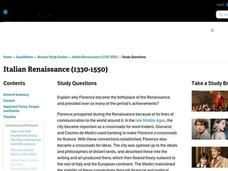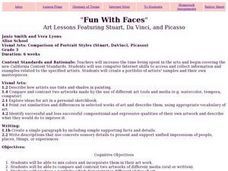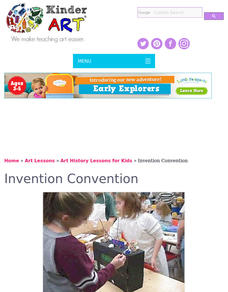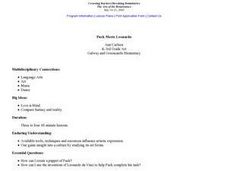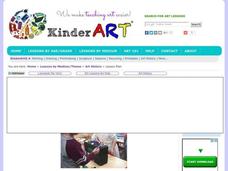Curated OER
An Exploration of Leonardo da Vinci's Life and Work
The original Renaissance man, da Vinci is a wonderful subject through which to discuss history, art and science.
Curated OER
Give It All You’ve Got Heroes and Visual Art
Sure, your young artists probably know Van Gogh and Picasso, but are they equally as familiar with Frida Kahlo and Andy Warhol? Small groups examine the work of famous artists. Then, they create their own hero portraits in Cubist style...
Curated OER
Renaissance Flash Cards
Provide your class with a set of flash cards all related to the people of the Renaissance period. There are ten cards total that are intended to help learners recall who, what, and when about Renaissance art and architecture.
Houghton Mifflin Harcourt
Renaissance and Reformation Chapter Review
Review key terms, vocabulary, sequence of events, and themes from the Renaissance and Reformation with this textbook chapter review. While designed by a publisher for a particular text, this resource can be incorporated into any...
Ballard & Tighe
Mingle and Match
From Michelangelo and Rembrandt to perspective and apprentice, check out this simple matching activity for your young learners to use when reviewing Renaissance key terms.
Practical Pages
Famous Artists Lapbook
Create mini books with some of the most beautiful and well-known masterpieces of our time. Learners read short paragraphs about famous artists such as Pablo Picasso, Leonardo da Vinci, and Johannes Vermeer, and create different kinds of...
Ballard & Tighe
Multiple Choice Masterpiece
What a fun way to mix up your traditional multiple-choice quiz on the Renaissance! After completing a instructional activity reviewing significant Renaissance artists and events, your learners will have the opportunity see if tiles that...
Curated OER
Italian Renaissance (1330-1550)
Is your class studying the Italian Renaissance? This resource includes 10 short answer and essay questions about the artistic, scientific, political, and philosophical achievements during the Italian Renaissance. The first 3 questions...
Curated OER
Lesson Plans for Portrait of the Young Countess Schouvalof
Students analyze the art for the Young Countess of Schouvalof and also practice recognizing the work of Le Brun, Leonardo da Vinci, and Andy Warhol. In this portrait art lesson, students analyze copies of the artists work and mark on the...
K12 Reader
Major Art Periods
After examining a brief article about the major art periods, readers use the provided graphic organizer to identify the main idea and supporting ideas in the paragraph.
Curated OER
Art and Anatomy: The Vitruvian Teen
Twelfth graders create an artistic version of a Vetruvian teen. In this anatomy instructional activity, 12th graders design an experiment to test the theory of the ideally proportioned man. They present their findings in class.
Curated OER
Fun With Faces: Stuart, Da Vinci and Picasso
Third graders conduct research and review art work to compare the styles of Stuart, Da Vinci and Picasso. They develop and compile a portfolio including masterpieces of these artists and original works. Students compose detailed...
Curated OER
I Wonder What You're Thinking, Mona Lisa
The enigmatic expression of Leonardo da Vinci's "Mona Lisa" prompts kids to imagine what this famous lady is thinking. First they fill in a thought bubble and then they explain why they believe these are her thoughts.
Dick Blick Art Materials
Start with a Circle...
The Golden Ratio. The Divine Proportion. Yup. It's math and art blended into one colorful activity. Young artists combine colored tissue paper circles and parts of circles to create geometric patterns. As a bonus, kids get to figure out...
Curated OER
Invention Convention
Fifth graders recognize the work of Leonardo da Vinci. They invent a new machine for the 21st century and make a model of the invention.
Curated OER
What a Wonderful World!
In this Leonardo da Vinci worksheet, students read that Leonardo da Vinci was a curious man and always questioned things in the world around him. Students then create questions of their own about animals, art, science and history. The...
Curated OER
The Art of "Green" Flying
Students create an airship that doesn't use fossil fuel. In this flying lesson, students research different types of flying machines that only use wind power. They discuss invention designs by Alexander Graham Bell and Leonardo Da Vinci...
Curated OER
Four Armed Men From the Renaissance!
Students study the Renaissance and the important art from the period. In this Renaissance lesson, students discuss the black plague and religion during the Renaissance. Students read the Renaissance worksheet and learn vocabulary words...
Crayola
Picture-Perfect Portraits
Children research the paintings of Italian artist Raphael and compare them to the works of Michelangelo and Leonardo da Vinci. They engage in close observations of one person while they prepare to paint a portrait. They create original,...
Curated OER
Leonardo da Vinci
Students select appropriate tools and technology to perform tests, collect data, and display data. They construct appropriate graphs from data and develop qualitative statements about the relationships between variables.
Curated OER
Puck Meets Leonardo
Students create a puppet of Puck from the story read aloud. Then they identify how they can use the inventions of Leonardo da Vinci to help Puck complete his task. Students also observe the inventions of Leonardo from books and online...
Curated OER
Invention Convention
Invent a new machine for the 21st century and make a model of the invention in this cross-curricular activity about Leonardo da Vinci. Young inventors will use various art supplies to create their models. The activity includes resource...
Huntington Library
Light in Painting
How do painters use and manipulate light in their artwork to give emphasis and establish mood and emotion? Pupils will analyze a few examples of landscape and portrait painting in order to explore the how light is used in art,...
Museum of Science
Open Window: Using Leonardo's Perspectograph
Students look through one eye and trace the outlines of objects seen through a window to create a drawing with natural and correct perspective.









